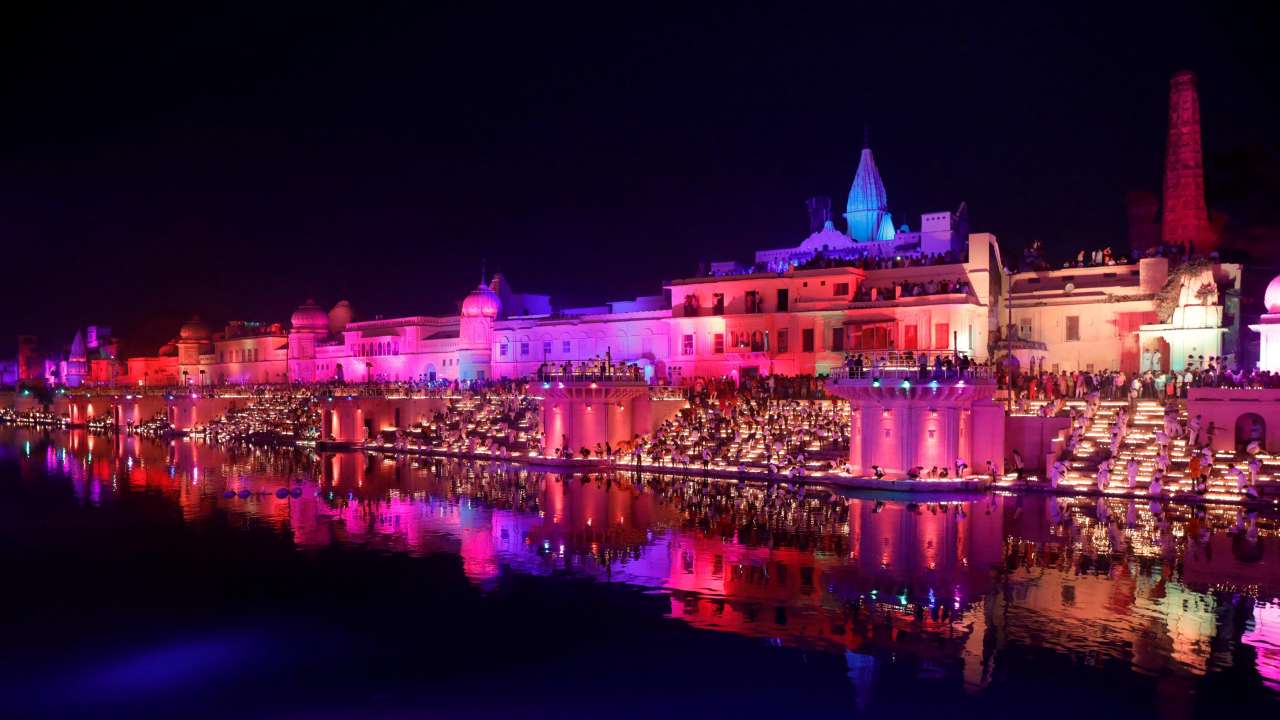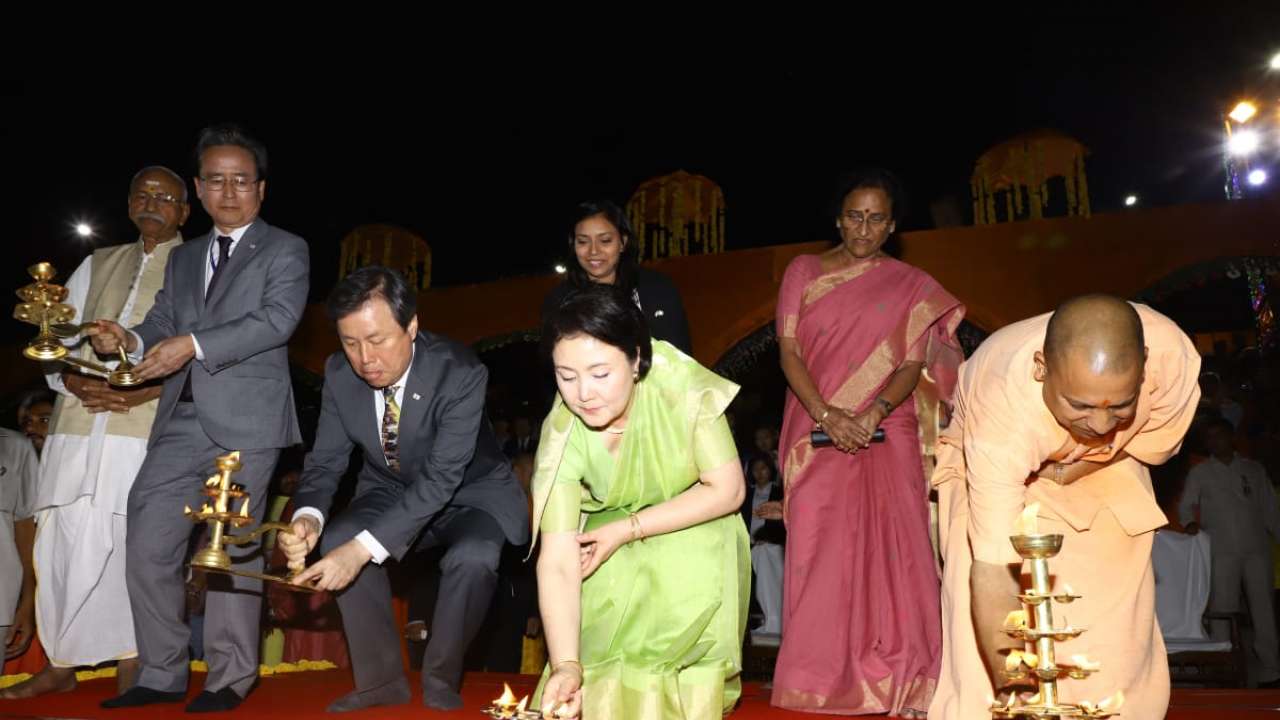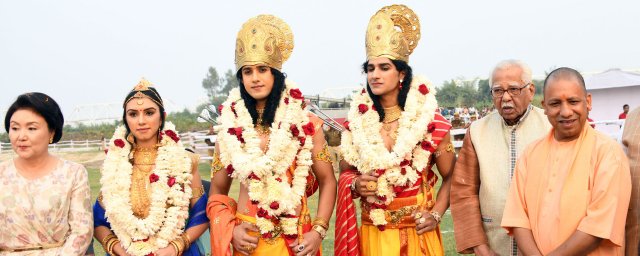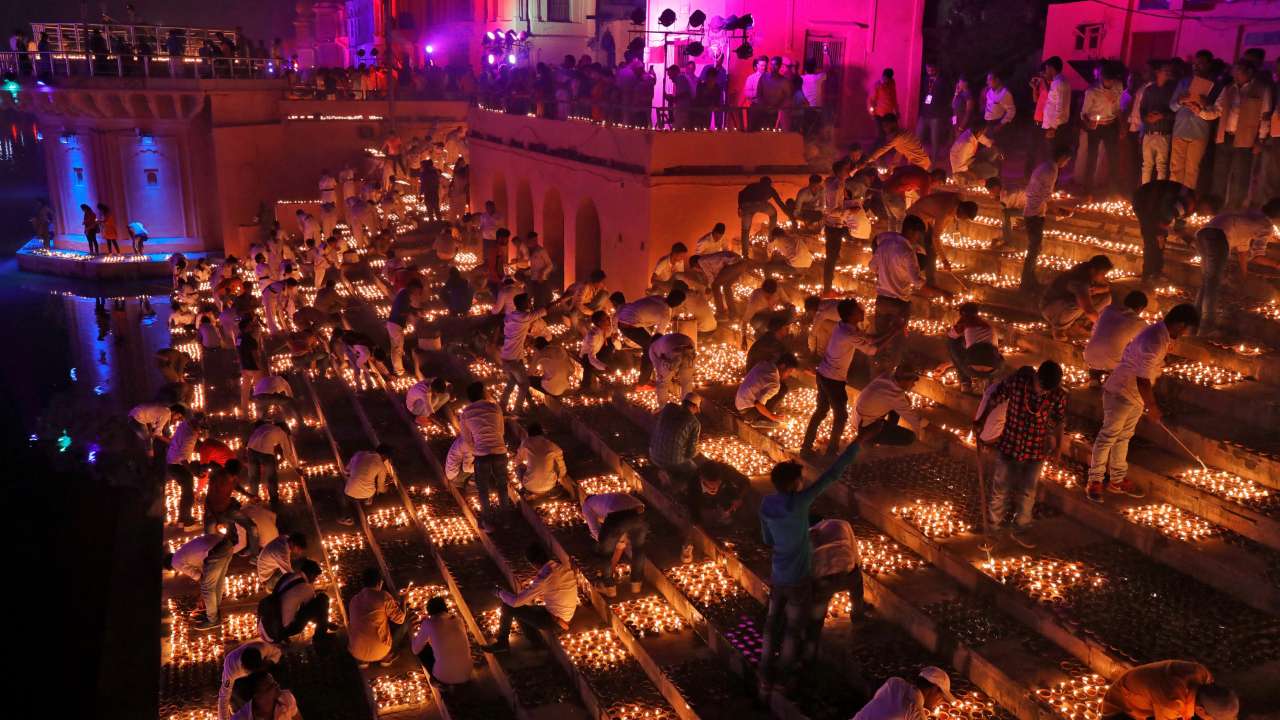
The three-day spectacular Deepotsava-2018 in Ayodhya concluded by restoring the ancient glory of the historic city, as the Chief Minister Yogi Adityanath, in the presence of Korean First Lady Kim Jung-sook, announced to rename the District as Ayodhya and unfolded scores of developmental schemes
On the evening of Kartik Krishna Chaturdashi (November 6, 2018) as the Sun started setting and dark began spreading its blanket, the banks of Sarayu River in Ayodhya illuminated with the light of three lakh one thousand and one fifty-two lamps. These lamps were lit at Ram Ki Pauri within 40 minutes of the Chief Minister Yogi Adityanath lighting a 16 feet high hydraulic lamp. Over 5,000 school students and NCC cadets helped in lighting the lamps. It was not merely the display of cultural prosperity, rich traditions and celebration of a festival, but creating a world record of lighting largest number of lamps simultaneously and also restoring the ancient glory of the historic city of Ayodhya. The representatives of ‘Guinness Book of World Records’ presented a certificate of lighting the largest number of lamps at a time to the Chief Minister Yogi Adityanath instantly.
Not only the banks of Sarayu, but entire Ayodhya also dazzled with light. The lighting reminded the people of the glory of Treta Yuga when Shri Ram along with Sita and Lakshman returned Ayodhya after defeating Ravana. The replication of the landing of Shri Ram through the Pushpak Viman, grand welcome by people and the subsequent coronation made those moments alive. The presence of the first lady of South Korea Kim Jung-sook doubled the jubilation. When the ‘Pushpak Viman’ landed at Ram Katha Park, thousands of people welcomed the artists dressed as Sri Ram, Sita and Lakshman by showering flower petals. They were formally welcomed by the CM and other dignitaries. The showering of flower petals by a helicopter made the entire scene highly emotional.


Korean First Lady performing Sarayu Aarati in Ayodhya
Addressing the gathering, CM Yogi Adityanath declared renaming of Faizabad District as Ayodhya and that the new Medical College in the city would be named after King Dashrath. He also announced setting up of an airport in Ayodhya to be named after Sri Ram. He said ‘Ram ki Pauri’ in Ayodhya would be developed like Har-ki-Pauri in Haridwar and no nullah would be allowed to throw its effluent in the Sarayu River directly. Without making any direct reference to the reconstruction of Shri Ram Temple, he said: “I know what whole of Ayodhya wants. I want to assure you that no injustice will be done to Ayodhya.”
“When we talk about Sri Ram, one conjures up an image of Ram Rajya. In the last four and a half years, the Narendra Modi Government has worked to restore Ram Rajya. Policies have been launched under which 36 crore bank accounts have been opened for the people in which over Rs 86,000 crore have been deposited. Under Aayushman Bharat scheme, the deprived people have been given free health care, while they are also given free electric and gas connections. This is what is a Ram Rajya, where all the people are getting benefits from the State,” the CM said adding that the Prime Minister has proposed a Ramayana Circuit starting from Janakpuri to Sri Lanka. This circuit would be the embodiment of India’s policy that it wants peace. He said the PM started a bus service from Janakpur in Nepal to Ayodhya and this time on the occasion of the wedding of Ram and Janaki he would himself go to Janakpur. The CM along with South Korean First Lady Kim Jung-sook, Governor of Uttar Pradesh Shri Ram Naik, Governor of Bihar Shri Lalji Tandon, Union Minister of State for Foreign Affairs Shri VK Singh and his cabinet colleagues performed ‘aarti’ of the Sarayu.

Welcoming the artists dressed as Sri Ram, Sita and Lakshman

Welcoming the artists dressed as Sri Ram, Sita and Lakshman
Earlier in the day, the CM inaugurated projects worth Rs 176 crore for Ayodhya. He along with the South Korean First Lady Kim Jung-sook laid the foundation stone for a memorial to Queen Heo Hwang-ok who, according to a Korean legend, was an Ayodhya princess who married King Suro of Geumgwan Gaya. The memorial would be built over an area of 10,000 sq. mt. “Those who divert from their past are like Trishanku. We are here in Ayodhya to connect with our history. Delegates from Korea are here to connect with their past. Korea is a witness that Ayodhya’s recognition should be only in the form of Ayodhya,” the CM said.
Draped in an elegant green saree, South Korean First Lady Kim Jung-sook enjoyed Diwali festivities in the historic city. From the moment she arrived in Ayodhya till she departed, local people applauded and cheered her at the multiple events. As her chopper landed near Ram Kath Park, a group of people welcomed her with the slogans of ‘Jai Shri Ram’. She began her Ayodhya tour by offering tributes at the Queen Heo Memorial. She attended a ground-breaking ceremony for the upgrade and beautification of the memorial dedicated to the legendary princess of Ayodhya who went to Korea and married a king there in 48 AD. From there, she went to attend festivities at Ram Katha Park, where she was greeted by artists donning Sri Ram and Sita and Lakshman. She garlanded ‘Sita’ as they got off the helicopter and state Governor Ram Naik and Adityanath welcomed ‘Sri Ram’ and ‘Lakshman’.


In her speech at Ram Katha Park, Kim Jung-sook recalled the historical ties between India and Korea and said she prayed for prosperity of both the countries, as they move towards a future of peace and prosperity together. She also mentioned Mahatma Gandhi and Rabindranath Tagore, and said in Korean, “There is an Indian adage that sharing happiness multiples it. I am very happy to celebrate Diwali in Ayodhya with all of you. Darkness cannot defeat light, and if we all light up lamps together, we can remove any darkness.”
At the main function, where a huge stage in traditional Indian architectural style was erected, Kim Jung–sook greeted the people with folded hands. Her visit to India indeed rekindled interest in the legendary princess of Ayodhya who married a Korean king. According to Korean legend, the Princess of Ayodhya went to Korea in 48 AD and married King Kim-Suro. A large number of Koreans trace their ancestry to this legendary princess, who is known as Queen Heo Hwang-ok.
As part of the Deepotsava-2018, various activities were carried out. A grand procession along with 15 tableaux began from Saket Mahavidyalaya and reached Hanuman Gufa after passing through the main road of the city. More than 500 artists, including artists from Korea, Russia, Laos and Trinidad, joined the procession. The tableaux prominently displayed various scenes from Ramayana. Huge gatherings of people welcomed the procession by showing flower petals.














Comments